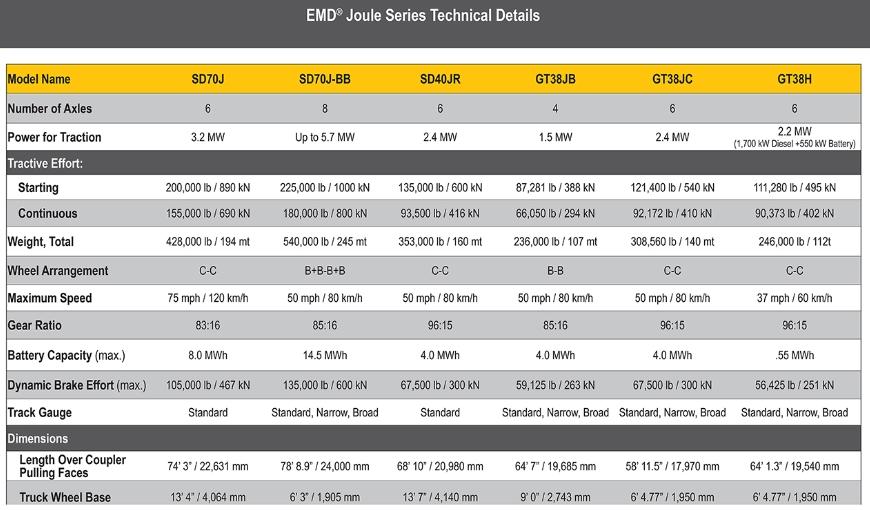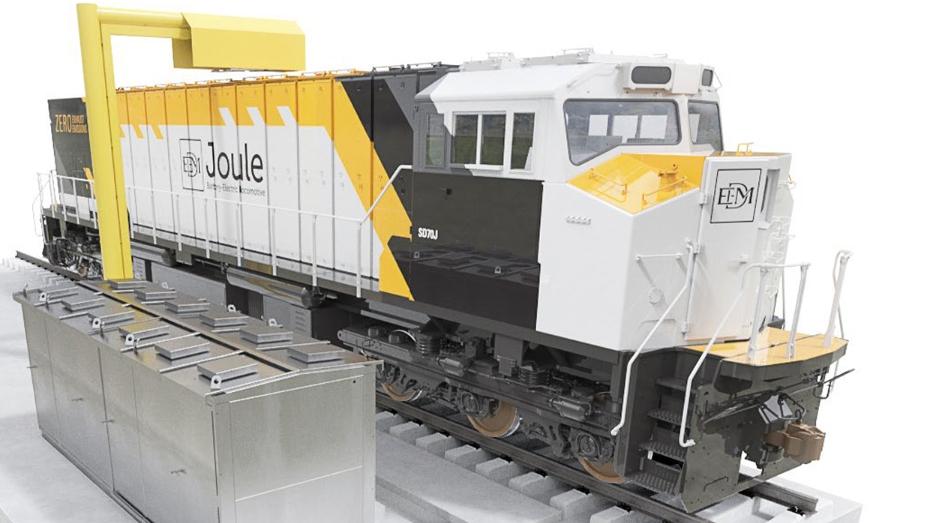Shifting from steam to diesel required over two decades, and the transition to zero emissions will likely extend for a considerably longer duration
Whether it’s battery-electric, hybrid, biofuel, hydrogen fuel cells, or enhancements to the reliable diesel-electric systems, the motive power industry is brimming with environmentally friendly technologies. The prevalent phrases used are “decarbonization” and “zero emissions.”
The Association of American Railroads underscores the rail industry’s dedicated efforts to advance technologies that reduce emissions and work toward a more sustainable future. Railroads are actively pursuing strategies to decrease emissions related to current locomotive technology and are progressing towards lower and zero-emission technologies that are currently in research, development, and demonstration phases. Many railroads have ongoing demonstration programs for alternative fuel locomotives, which show significant potential as future solutions with lower or even zero emissions.
This transition will be a lengthy process. The railroad industry boasts a rich history spanning almost two centuries, with 167 years of documented history in the pages of Railway Age. The diesel-electric locomotive, which will continue to serve as the industry’s primary motive power source for years to come, made its debut in 1920. It remains uncertain whether historians in the 22nd century will view the year 2023 (or thereabouts) as a significant milestone, marking the initial steps away from diesel-electric locomotion. Alternatively, it might require another 10 to 20 years of development and testing, followed by an additional 10 to 20 years of transition, which could push this historical turning point further into the future.
Progress Rail is fully embracing a wide array of alternative propulsion technologies. Originating as Electro-Motive Corporation in 1922, and later known as EMD (Electro-Motive Division of General Motors), the brand played a pivotal role in advancing dieselization with the FT locomotive in 1941. Today, Progress Rail envisions a dynamic market for its EMD® product line, encompassing battery-electric, hybrid, and hydrogen fuel cell (HFC) propulsion, alongside diesel-electric locomotives powered by bio-diesel blends, renewable diesel, hydrogen/diesel blends, or pure hydrogen. The possibilities are extensive, and there is no one-size-fits-all solution.
“We are actively pioneering advanced solutions with a strong emphasis on our customers’ interests and their capacity to secure funding for further investments,” states Paul Denton, Senior Vice President of International Sales, Technology & Marketing. “There are numerous emissions-reduction pathways that are environmentally sound and do not necessitate railroads to completely replace their existing diesel engine investments.”

Progress Rail’s flagship among its alternative propulsion endeavors is appropriately named the EMD® Joule. It is available in five configurations, whether new or repowered, denoted with “R”:
- SD70J (6 axles, maximum 8.0 MWh battery capacity);
- SD70J-BB (8 axles, 14.5 MWh);
- SD40JR (6 axles, 4.0 MWh);
- GT38JB (4 axles, 4.0 MWh);
- GT38JC (6 axles, 4.0 MWh).
All of these models incorporate regenerative braking for battery replenishment. Customers have the flexibility to specify their preferred MWh rating, up to the maximum limit. Additionally, the modular EMD® Joule Charging Station is available for stationary charging, with options in 700- and 1,400-kW configurations.
In Southern California, BNSF is slated to receive delivery of up to four SD70Js with charging stations in the coming year. With an impressive 8 MWh of storage capacity, these locomotives will claim the title of “the most powerful battery-electric locomotives in North America.” CARB (California Air Resources Board) and EPA grant funding are contributing to BNSF’s procurement of these advanced units.
The SD70J-BB boasts an impressive 14.5 MWh of battery capacity, making it the industry’s leader in this regard. BHP Western Australia Iron Ore has plans to test two of these locomotives early next year. During the trial, regenerative braking, also known as “energy capture,” will be employed to charge the batteries, taking advantage of the natural terrain along the rail network to reduce overall power consumption. As the locomotives descend from the Pilbara mine to BHP’s Port Hedland export facility, they will capture energy from regenerative braking, which will then be utilized to assist empty trains on their return journey to the mine. Meanwhile, FMG/FFI (Fortescue Metals Group) is set to receive two units for their Australian iron ore mining operations later this year, with manufacturing taking place at Progress Rail’s facility in Sete Lagoas, Brazil.
Brazil’s Vale S.A., a prominent metallurgical and mining company, was one of the first collaborators with Progress Rail on their inaugural battery-electric locomotive project. According to Senior Vice President of Engineering Mike Ramm:
“In collaboration with Caterpillar, our engineering teams worked on designing a locomotive tailored for this specific application.”
He further explains that this endeavor gave rise to the GT38J, which is a meter-gauge and low clearance variant based on the SD40JR, marking the commencement of their venture into battery-electric locomotives.

The most recent addition to the Joule lineup is a standard-gauge locomotive designed for Pacific Harbor Line (PHL) and is presently undergoing testing at MxV Rail in Pueblo, Colorado. Mike Ramm highlights the suitability of battery locomotives for specific railway applications, emphasizing yard service as an excellent example. This aligns with PHL’s interest in procuring the SD40JR for their operational needs.
Progress Rail opted for LiFePO4 (lithium iron phosphate) batteries for their locomotives. Mike Ramm highlights the significance of battery chemistry and its usage in the locomotive industry. He explains that the choice depends on factors such as the need for rapid discharging/charging in highly cyclic applications versus the preference for stability. Ramm also notes that batteries have a limited lifespan, similar to those in cell phones, where repeated charging and discharging can lead to reduced battery life, a consideration that applies to locomotives as well.
Hybrid propulsion, which combines diesel engines with batteries, is another offering from Progress Rail. In early 2023, Brazilian logistics and transportation company Rumo Logística will receive two EMD® GT38H intermediate-power locomotives, marking the debut of hybrid locomotives in revenue freight service. These locomotives utilize modular architecture to accommodate different energy sources while maintaining the capabilities of their diesel counterparts. They can perform both regenerative and external battery charging, making them versatile in reducing fuel consumption and emissions, according to Mike Ramm.
In the context of longer-distance line-haul and high-power applications, hydrogen fuel cells (HFC) hold potential, provided certain limitations can be effectively addressed. Michael Cleveland, the Director of Advanced Energy, elaborates on the workings of a hydrogen fuel cell vehicle, which fundamentally operates as an electric vehicle featuring electric traction motors and a battery system. The fuel cell supplements or recharges the battery by utilizing stored hydrogen and extracting oxygen from the air, similar to a battery. However, one drawback of fuel cells is their suboptimal performance under load fluctuations, such as when a freight locomotive transitions from full power (Notch 8) to idle within minutes. To mitigate this issue, the approach involves combining the fuel cell with a battery system capable of managing load fluctuations.
The insights gained from battery technology are being integrated with fuel cell development. Michael Cleveland highlights that hydrogen holds approximately 20% of the energy by volume compared to diesel fuel. As a result, for extended long-haul operations, particularly for Class I railroads, an external hydrogen tank, known as a tender, will be required. Despite facing certain challenges, the appealing aspect of hydrogen as an option lies in the fact that its only byproduct is water, making it an environmentally attractive choice.
In December 2021, BNSF, Chevron U.S.A. Inc., and Progress Rail signed a memorandum of understanding (MOU) to conduct a demonstration of a hydrogen fuel cell (HFC) locomotive. The objective is to verify the practicality and performance of hydrogen as a feasible substitute for conventional fuels in long-distance rail transport, as stated by Progress Rail. Hydrogen holds promise as a low-carbon option compared to diesel fuel for transportation, and hydrogen fuel cells are emerging as a solution to mitigate emissions.
“As a subsidiary of Caterpillar, we are deeply engaged in the energy transition throughout our entire enterprise. Our technology investments, spanning hydrogen, battery, electric, and hybrid locomotives, are being collaboratively developed with our parent company,” remarks Denton.
“When we combine our powertrain advancements with our existing technology suite for fuel efficiency, such as Talos energy management and our Nitro Suite of yard and network optimization decision support tools, we make a substantial contribution to our customers’ capacity to operate with greater efficiency and safety, all while assisting them in attaining their ESG objectives.”



